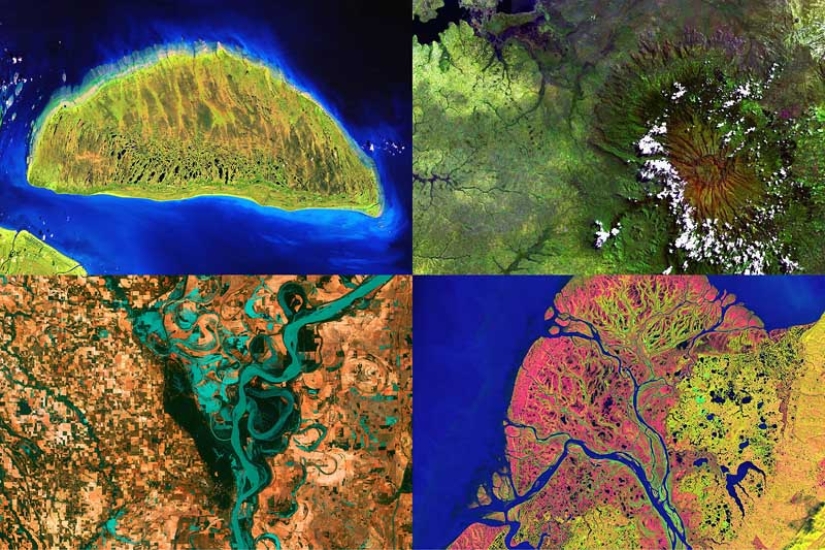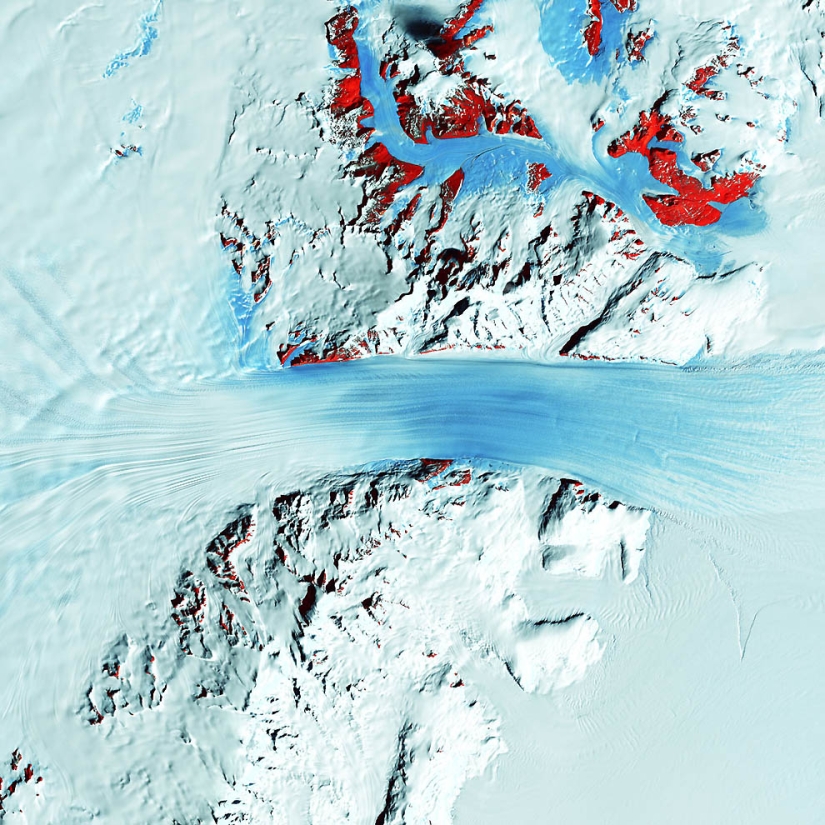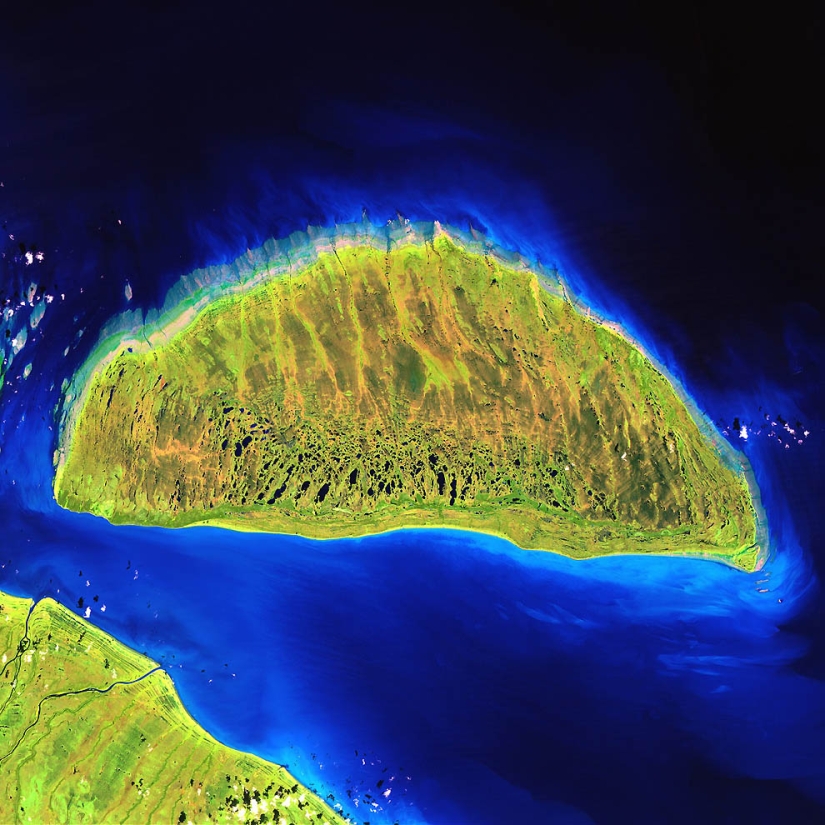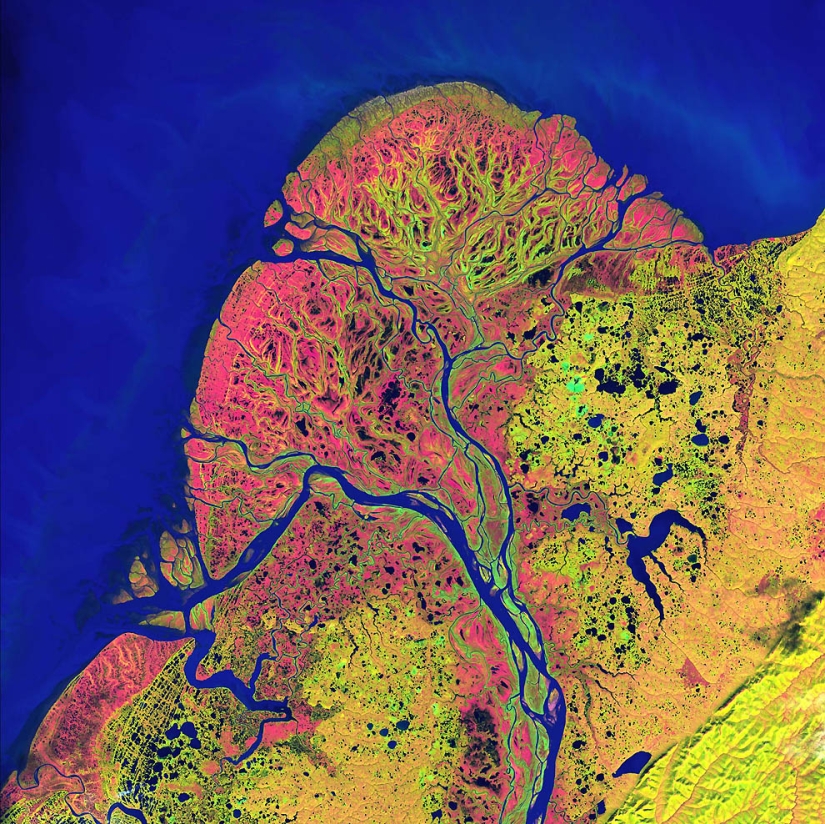The beauty of the planet - a view from above
Categories: Space
By Pictolic https://pictolic.com/article/the-beauty-of-the-planet-a-view-from-above.htmlTo paraphrase a well-known saying, we say: "Beautiful is seen from a distance." If someone manages not to notice how beautiful our planet is, this selection of photographs will convince him, and anyone else, that we all live in a wonderful world. It is sometimes worth looking closely at what is around, and try not to spoil such beauty.


Small squares of cities, fields and pastures contrast sharply with the graceful curves of the Mississippi River. Countless lakes and offshoots accompany the meandering course south of Memphis, Tennessee, on the Arkansas-Mississippi border. The mighty Mississippi is the largest river in North America. (USGS / NASA)

Byrd Glacier is a real ice river in Antarctica: moving relatively quickly through the Transantarctic Mountains at a speed of 0.8 km per year. The 180 km glacier flows from the polar plateaus (left) into the Ross Ice Shelf (right). The long, broad streamlines are intersected in places by shorter streamlines, which are deep cracks in the ice. In this color multispectral image, red patches indicate areas of rocks protruding from beneath the ice. (USGS / NASA)

The bright crimson streak in the center of this photo is the remains of extensive lava and mud flows. Their source is the currently dormant Anyuyskiy volcano in northeastern Russia, viewed here (orange round spot at the right end of the band). The remote and largely inaccessible region is a range of high volcanic mountains, many steep valleys, and wild, snow-fed rivers and streams. (USGS / NASA)

The Caicos Islands in the northern Caribbean are a popular tourist destination known for their beautiful beaches, clear waters, dive sites and luxury resorts. The islands lie primarily along the northern perimeter of the Caicos Underwater Bank, a limestone formation covered with sand, algae and coral reefs covering 6,140 square kilometers. (USGS / NASA)

Small clouds cast a shadow over Rub Khali near the border between Saudi Arabia and Yemen. Rub Khali is the world's largest desert with sandy seas. A high mountain range juts out into the waves of the sandy sea. At the far end of the range lies the Saudi city of Sharurah. (USGS / NASA)

Like distant galaxies against interstellar dust clouds, chunks of ice drift through graceful swirls of icy tallow in the frigid waters of Fox Bay near Baffin Island in the Canadian Arctic. Sea ice often starts as icy sebum, thick patches of tiny ice crystals on the surface of the ocean. As the temperature drops, the ice fat hardens and coalesces into slabs of harder ice. (USGS / NASA)

This stretch of Iceland's north coast resembles a tiger's head, with stripes of orange, black and white. The mouth of the tiger is Eyjafjordur, a deep fjord that juts out into the interior of the mainland between steep mountains. The name means island fjord, and comes from the small teardrop-shaped island at its mouth. The ice-free port city of Akureyri lies near the narrow tip of the fjord and is Iceland's second most populated city after Reykjavik. (USGS / NASA)

During the last ice age, Akimiski Island in James Bay lay under a huge mass of glaciers. When the climate changed and the ice receded, Akimski began to gradually emerge from under the ice. The slow but steady increase in height of the island can be traced by the natural terraces at its edges, where the coastline has taken on a specific form as a result of the growth of land and the impact of waves on different levels of the coast. (USGS / NASA)

Clouds surround the high mountain Elgon in Africa, a huge, long-extinct volcano on the border of Uganda and Kenya. The lone volcano is one of the world's largest intact calderas, a central depression. The caldera, about 6.5 km across, was formed after an eruption, when an empty magma chamber collapsed under the weight of volcanic rocks above it. (USGS / NASA)

What appears to be a wide streak of red paint is actually a wonderful play of light and clouds in the Canadian Rockies. The lowland is part of the Rocky Mountain Valley, which extends from Montana south of the Yukon. Low clouds filled the low on the border between the Canadian province of Alberta and British Columbia. The reflective characteristics of the clouds combined with the low altitude of the sun above the horizon create such a striking effect. (USGS / NASA)

Like bony fingers, strips of land stretch across the section of Liverpool Bay along the northern edge of Canada's Northwest Territories. In this remote and inhospitable region of the Arctic tundra, bordering the Beaufort Sea, there are only small villages, but they are very far from each other. The relatively flat landscape is dotted with shallow lakes during the extremely short summer season. (USGS / NASA)

Vibrant colors and bizarre shapes in the photo with false colors. This labyrinth of exotic designs winds its way around the edge of Russia's Chaun Bay in northeastern Siberia, visible as a bright blue semicircle at the bottom of the image. Two large rivers, Chaun and Palyavaam, flow into the bay, which, in turn, opens into the Arctic Ocean. Receding glaciers have created a huge number of swamps and lakes here. (USGS / NASA)

Like a monstrous cannibal with something sticky in its mouth, the Darja Peninsula in western Turkmenistan is surrounded by the shallow coastal terraces of the Caspian Sea. Strong winds create huge sand dunes near the water, some of which are partially covered by water. Further inland, the dunes give way to low-lying sandy plains. (USGS / NASA)

From its source in Northern British Columbia and through the Yukon Territory in Canada, the Yukon River in Alaska flows into the Bering Sea. Countless lakes, ponds and meadows are scattered throughout the river delta. The winding and branched channel resembles blood vessels. It is one of the largest river deltas in the world and is currently a National Wildlife Refuge. (USGS / NASA)
Recent articles

There are many places in the world where only the chosen ones can be. The cities of Mecca and Medina in Saudi Arabia are well known ...

This collection of photos will clearly please the little inner perfectionist who lives in each of us. It doesn't matter how much ...

If you don't feel good about the donut you ate for lunch, relax - it can get worse ... At least you didn't eat the ...